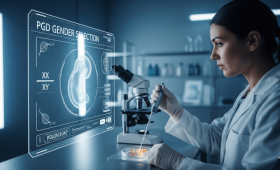The Biology of Ovulation
At the heart of the fertility journey is the accurate timing of when conception can occur. Once an egg is released from the ovary in hopes of fertilization, it can survive for approximately 12 to 24 hours before the window for conception closes until the next cycle. However, since sperm can survive inside the body for up to three to five days, it is critical to have intercourse not only on the day of ovulation but also on the days leading up to it to maximize the chances of pregnancy. This creates a critical “fertile window” that can last up to six days, encompassing the five days leading up to ovulation and the day of ovulation itself. Understanding and properly tracking this window is arguably the single most important factor in achieving conception.
Practical Strategies for Tracking Ovulation
There are several methods available to accurately pinpoint the fertile window. The body provides several physical cues to impending ovulation, and learning to read these signals is a powerful tool for increasing the chances of conception.
- Cervical Mucus: As ovulation approaches, the cervix releases mucus to help sperm travel through the cervix and on to the egg. This mucus is typically observed to be of a thick, slippery, and wet consistency, similar to that of raw egg whites. Daily observation and charting of this change is a key indicator that the most fertile period is approaching.
- Basal Body Temperature (BBT): BBT is the body’s lowest resting temperature, measured before getting out of bed upon waking. It dips slightly just before ovulation, then rises and stays elevated as a sign that ovulation has occurred. While this method is useful for confirming that ovulation has taken place in retrospect, it is less effective for timing future intercourse since the increase occurs after the fertile window. However, it remains a valuable tool for identifying the overall pattern and regularity of ovulation in a cycle.
- Ovulation Test Kits (OPKs): These test strips work by detecting the surge in luteinizing hormone (LH) in the urine that happens just before ovulation. When used correctly, ovulation tests are reported to be 95% to 99% accurate in detecting the LH surge. It is important to note, however, that they can give false positives or multiple surges in conditions such as polycystic ovary syndrome (PCOS).
- Integrating Technology: Free phone applications such as Kindara, Glow, and Flo provide convenient tools to track and record information such as menstrual cycle length, past cycles, and other relevant data. These apps can help individuals learn more about their own bodies and identify their fertility patterns.
- Other Ovulation Signs: These may include an increase in sex drive, breast tenderness, abdominal cramps or pain (known as mittelschmerz), bloating, and changes in mood.
Debunking the Myth: Infertility is Not Just a Female Issue
It is a common assumption that infertility is primarily a woman’s issue; however, scientific data definitively debunks this myth. Research shows that approximately one-third of infertility cases are due to female factors, one-third are due to male factors, and the remaining third are a combination of both partners or are unexplained. It is therefore essential for a couple trying to conceive to adopt a holistic approach that considers the overall and reproductive health of both partners. Male fertility relies on factors such as sperm count, motility, and morphology. Lifestyle factors, including smoking, alcohol, and excessive heat exposure, can all negatively impact sperm health. This means that the male partner must be an active participant in the efforts to improve conception.
Table 1: Ovulation Tracking Methods: A Practical Guide
| Method | How It Works | Accuracy | Advantages | Disadvantages |
| Cervical Mucus | Involves observing the wet and slippery “egg-white” consistency of mucus. | Fairly good but requires individual interpretation. | Free and relies on the body’s natural signals. | Accurate interpretation requires practice. |
| Basal Body Temperature (BBT) | Charts the temperature spike that occurs after ovulation. | Highly accurate for confirming ovulation has occurred. | Inexpensive and confirms cycle regularity. | Does not predict ovulation in advance, only confirms it in retrospect. |
| Ovulation Test Kits (OPKs) | Detects the LH surge in urine right before ovulation. | 95-99% accurate when used correctly. | Pinpoints the most fertile days leading up to ovulation. | Potential for false positives or multiple surges; can be difficult with irregular cycles. |
The Holistic Approach
The Central Role of Diet and Nutrition
Fertility is not only about proper timing; it’s also about creating an environment within the body that supports the fundamental biological functions necessary for reproduction. Diet can have a positive or negative impact on both male and female fertility. Studies show that a diet rich in trans fats, processed foods, and added sugars can have a negative effect on fertility. In contrast, a diet rich in fiber, omega-3 fatty acids, plant-based proteins, vitamins, and minerals has been shown to have a positive impact on fertility. Such diets often mirror the Mediterranean-style diet and emphasize low-glycemic index (GI) foods.
The importance of these nutritional recommendations lies in a series of metabolic mechanisms. A diet full of sugary, high-GI foods can disrupt the body’s insulin response, leading to insulin resistance. This can result in an increase in blood sugar (hyperglycemia) and an excess of insulin in the blood (hyperinsulinemia). These hormonal imbalances can lead to ovulation disorders and conditions like polycystic ovary syndrome (PCOS) in women. In men, hyperglycemia can negatively impact sperm motility and DNA integrity and has been linked to erectile dysfunction. Therefore, eating right is not just about getting vitamins but about regulating the complex hormonal and metabolic balance required for reproductive health. Inflammatory foods, such as fried foods, saturated fats, processed meats, sugary drinks, and refined flours, should be avoided.
The Essential Role of Vitamins and Supplements
In addition to a healthy diet, supplementing with certain key vitamins and minerals is recommended to boost fertility. These supplements play a critical role in filling any nutritional gaps in one’s diet.
- For Women:
- Folic Acid (Vitamin B9): This B vitamin is vital before conception and in the first few weeks of pregnancy to prevent serious birth defects of the fetal brain and spinal cord (neural tube defects). An intake of 400 to 800 mcg per day is recommended.
- Vitamin D: It is essential in supporting hormone balance and regular menstrual cycles, and women with adequate levels of vitamin D have been shown to have higher IVF success rates.
- Coenzyme Q10 (CoQ10): While not a vitamin, it is a powerful antioxidant that can improve egg quality and cellular energy production, especially in women over 35.
- Iron and Omega-3 Fatty Acids: Iron supports healthy ovulation and blood flow to the uterus, while omega-3s are important for regulating hormones and improving egg health.
- For Men:
- Antioxidants: Antioxidants like Vitamin C can protect sperm from oxidative stress and improve their quality.
- Coenzyme Q10 (CoQ10): Helps prevent damage to sperm caused by free radicals.
- Zinc and Selenium: Low levels of zinc have been linked to low sperm count and reduced testosterone, while selenium is needed for normal sperm production and development.
The Weight-Exercise Equation
Maintaining a healthy body weight is a fundamental component of fertility for both men and women. An ideal Body Mass Index (BMI) is within a healthy range of 18.5 to 24.9. This is more than just a number; it is a fundamental indicator of metabolic health. Being overweight or obese can lead to hormonal imbalances, ovulation issues, and irregular menstrual cycles in women. PCOS, in particular, is a common cause of infertility that is frequently associated with obesity. In men, obesity can alter hormone levels, reduce testosterone, and lead to a low sperm count and motility.
This highlights the profound effect that body weight has on reproduction. Bringing one’s body weight into a healthy range can help restore the fundamental metabolic and hormonal balance required for reproductive function. Studies have shown that for women who are overweight or obese, even a small weight loss of just 5% to 10% can significantly improve fertility and menstrual cycles. Regular physical activity also improves both general health and fertility. It is important, however, to avoid excessive exercise, as this can negatively impact fertility in both men and women.
Table 2: Key Nutrients for Conception: Function and Sources
| Nutrient | Role in Female Fertility | Role in Male Fertility | Common Food Sources |
| Folic Acid (B9) | Supports egg quality and cell division; prevents neural tube defects. | Supports sperm DNA and quality. | Leafy greens, beans, nuts, fortified grains. |
| Vitamin D | Supports hormone balance and regular menstrual cycles. | Linked to low testosterone levels. | Sunlight, fatty fish (salmon), supplements. |
| Coenzyme Q10 | Boosts egg quality and mitochondrial function. | Prevents sperm damage from free radicals. | Fish, meat, whole grains. |
| Iron | Supports healthy ovulation and blood flow to the uterus. | — | Red meat, poultry, eggs, spinach, lentils. |
| Zinc | — | Low levels are linked to low sperm count. | Meat, dairy, shellfish, whole grains, nuts. |
| Selenium | — | Needed for normal sperm production and development. | Brazil nuts, fish, meat, eggs. |
| Omega-3 Fatty Acids | Regulates hormones and supports egg health. | Supports sperm quality and motility. | Salmon, walnuts, chia and flax seeds. |

Lifestyle Inhibitors
There are certain lifestyle factors that individuals should actively avoid to improve their chances of conception.
- Alcohol, Tobacco, and Drugs: Smoking and excessive alcohol use are significant risk factors for infertility in both men and women. In men, smoking reduces sperm count and motility. In women, it can lower egg quality and ovarian reserve, increasing the risk of ovulatory infertility. Heavy alcohol use can lead to ovulation disorders in women and a lower sperm count and quality in men. The combination of these habits can further compound the risk of infertility and increase oxidative stress, which harms both sperm and egg health.
- Caffeine Consumption: The scientific evidence on the effect of caffeine on fertility is conflicting, but a cautious approach is recommended. Some studies suggest that daily caffeine intake of more than 200 mg in women can reduce the likelihood of a live birth. For men, caffeine consumption above 700 mg per day may be associated with a reduced likelihood of conception. It is therefore advised for both men and women to limit their caffeine intake to 200 mg per day when trying to conceive.
- Environmental Toxins and Heat: A frequently overlooked but significant factor affecting fertility is exposure to environmental toxins. Substances such as endocrine-disrupting chemicals (EDCs), heavy metals (lead, mercury), and pesticides can disrupt hormonal balance and diminish sperm and egg quality. The effects of these substances can be insidious and cumulative, gradually undermining reproductive health over time. For men, it’s also important to avoid prolonged exposure to excessive heat from sources like a laptop on the lap, hot tubs, and saunas, as this can negatively affect sperm production. Understanding these threats can help individuals make more informed lifestyle choices.
Addressing the Medical and Psychological Dimensions
Debunking Common Fertility Myths
Misinformation surrounding fertility can cause unnecessary stress and confusion. It is crucial to separate evidence-based facts from common myths.
Table 3: Fertility Myths vs. Evidence-Based Facts
| Myth | Evidence-Based Fact |
| Infertility is just a female problem. | Approximately one-third of infertility cases are due to male factors, one-third to female factors, and one-third to a combination of both or unexplained reasons. |
| Stress is the main cause of infertility. | While stress can affect health, there is no conclusive evidence that stress alone causes infertility. Infertility is a medical condition. |
| Lying with your legs in the air after sex helps sperm get to the uterus. | There is no scientific evidence to support this. Sperm reach the cervix within seconds regardless of position. |
| You can get pregnant at any time in your cycle. | Pregnancy is only possible during the six-day “fertile window,” which includes the five days leading up to ovulation and the day of ovulation itself. |
| Using birth control for too long will affect your fertility. | Hormonal birth control does not affect long-term fertility. It may take a few months for your body to regulate its menstrual cycles again. |
The Mind-Body Connection: Managing Stress
While there is no conclusive evidence that stress directly causes infertility, it is well-documented that it can significantly impact the fertility process. Chronic stress can elevate cortisol levels, which can inhibit the release of GnRH (gonadotropin-releasing hormone) in women and disrupt the menstrual cycle. Likewise, it can negatively affect sperm production and hormones in men. In fact, a vicious cycle often develops between infertility and stress: the struggle to conceive causes stress, which leads to behaviors that inhibit reproduction (e.g., poor nutrition, lack of sleep), which in turn makes conception more difficult, leading to more stress. Breaking this cycle is a critical step in overcoming the sense of helplessness that can accompany this process.
Practical strategies to break this cycle include:
- Physical Activity: Regular, moderate exercise, such as yoga, brisk walking, or swimming, releases endorphins and reduces anxiety.
- Mindfulness and Meditation: Mindfulness techniques, such as deep breathing exercises and quiet meditation, can calm the body’s “fight or flight” response, reducing heart rate and muscle tension.
- Building Support Systems: Seeking out support groups to connect with other individuals going through similar challenges or getting professional help from a therapist is recommended.
- Taking Breaks: Sometimes, stepping away from social media or “TTC talk” for a short period can be incredibly restorative, allowing an individual to reconnect with their hobbies and their partner. These actions give a person a sense of control over the situation, which can help break the cycle.
When to Consult a Fertility Specialist
While the first step for most couples is to focus on lifestyle optimizations and well-timed intercourse, it is crucial to know when to seek professional help. Evidence-based guidelines recommend consulting a fertility specialist in the following scenarios:
- For women under 35: After one year of trying regularly without success.
- For women 35 and older: After six months of trying regularly without success.
- Sooner, regardless of age: If there are known risk factors such as irregular cycles, a known diagnosis of PCOS, endometriosis, or a suspicion of male-factor infertility.
A fertility specialist is a doctor who has special training in diagnosing and treating medical conditions such as ovulation disorders (PCOS, thyroid issues ), endometriosis (a condition that can block fallopian tubes or cause inflammation ), or uterine fibroids. They are in the best position to educate couples on complex issues and determine the most appropriate course of treatment.
Conclusion
The journey to improving the chances of getting pregnant involves a complex interplay of timing, physiology, psychology, and lifestyle choices. The most important takeaway is that achieving conception is a holistic endeavor that requires the active participation of both the female and male partners. By implementing evidence-based strategies, such as tracking the fertile window, adopting a holistic lifestyle, and debunking common myths, individuals can take charge of their own fertility health. Proper nutrition, a healthy body weight, and stress management not only improve reproductive health but also contribute to overall well-being.
This guide acknowledges that the journey can sometimes be difficult and emotional. It is therefore essential to be patient with oneself and not hesitate to seek professional support. Ultimately, by taking informed and proactive steps, one can significantly improve their chances of success. It is important to remember that there are many different paths to becoming a parent, and there is always hope.



